 |
 |
|
 |
Molnau leads group to visit troops in Bosnia |
 |
 |
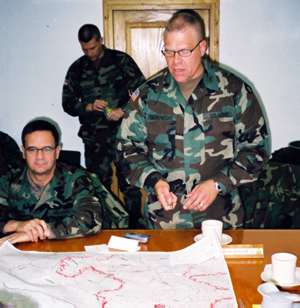 |
Lt. Col. Kevin Gutknecht, Metro district, shows where land mine fields
are indicated on the Bosnian map. He briefed the lieutenant governor
and her group on the missions the Minnesota soldiers are completing
and the risks involved. Although the Guard soldiers do not remove land
mines, they must know where they are. The red dots indicate land mine
fields. Photo by Lucy Kender
|
With strains of "I’ll be Home for Christmas" in the air, Lt. Gov.
Carol Molnau led a group of Minnesotans Dec. 20-23 to visit many of the 1,100
Minnesota Army National Guard soldiers on active duty in Bosnia. The group,
including 26 civic and business leaders and news media, traveled to Bosnia to
greet and thank the soldiers who have been stationed there since August 2002.The
Guard troops are scheduled to return to Minnesota in early spring.
Minnesota’s citizen-soldiers are part of the international peacekeeping mission
in the war-torn nation. Their mission includes showing an American presence,
helping rid the countryside of war munitions and working with citizens in the
surrounding communities.
"This trip was about the sacrifices the soldiers make," said Molnau,
who traveled in her role as deputy commander in chief of the Minnesota National
Guard. "We just wanted to show them how much we appreciate them.
"Wherever we went, we asked the soldiers what message they would like
us to bring home. To a person, they wanted to communicate to their families
and loved ones how much they miss them, but also how proud they were in completing
this difficult mission and helping make a difference."
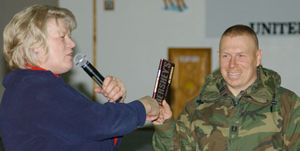 |
At the conclusion of a "town hall" meeting with members of
Task Force Iron, Lt. Gov. Molnau awarded a giant-size Hershey bar to
Capt. Jeff Wendland in appreciation of his interest in transportation
issues. The town hall meeting gave soldiers the opportunity to query
legislators and others on military-related legislation and gave the
leaders the opportunity to personally thank the soldiers for their sacrifices.
Photo courtesy of the Minnesota National Guard
|
In her role as transportation commissioner, Molnau also brought personal greetings
to two Mn/DOT employees: Lt. Col. Kevin Gutknecht, Metro district, and Maj.
Jody Gunlock, District 1.
"This has been a good mission. We are making a difference here. We can go home
proud, knowing that we've helped keep peace here. My soldiers are doing well.
They appreciate this mission," said Gutknecht. "We all miss our families
and home, no question. But we are getting excellent support from there, and
for that we are grateful."
Gutknecht commands the 350-person "Task Force Iron" made up primarily
of troops from Minnesota’s 2nd Battalion, 194th Armor located in Duluth and
Iron Range communities.
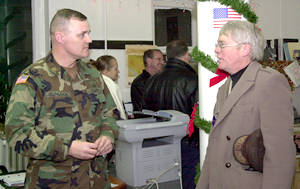 |
Maj. Jody Gunlock listens to a question from Steve Krikava, director
of government affairs for Land O Lakes, during the business leader’s
tour through his unit. Several business leaders visited with soldiers
as well as the local chamber of commerce in the hopes of establishing
business relationships. Photo courtesy of the Minnesota National
Guard
|
Gunlock serves as the executive officer with 2nd Battalion, 136th Infantry
"Task Force Bearcat." That battalion hails primarily from Minnesota’s
northwest corner. He has found a way to keep active during off-duty hours: he
sings in the chapel choir. The lieutenant governor and others attended a special
chapel service where Gunlock performed.
Currently, there are some 3,000 Minnesota National Guard soldiers on active
duty in countries around the globe. The support of civilian employers is critical
for the success of such missions.
One of the group members, retired Air Force Brig. Gen. Denny Shulstad, who
also serves as the chairman of Minnesota’s Employer Support of the Guard and
Reserve, presented a plaque to Molnau for her support of the Mn/DOT employees
and her support of all Minnesota’s deployed soldiers. He told the soldiers that
he tells employers they can expect a better employee—a better person—to return
to work after an experience like this mission in Bosnia.
For more information on the history of Bosnia and the American military involvement
there check: http://www.tfeagle.army.mil/.
By Lucy Kender |
back

|
 |
FAST Lanes plan gains momentum |
 |
 |
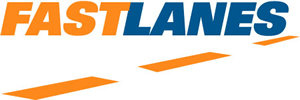 |
FAST lanes--publicly owned lanes paid for by private entities--will
be coming to Minnesota, according to an announcement the governor and
lieutenant governor made at a Dec. 29 news conference. Graphic logo
by Paula Gustafson
|
Gov. Tim Pawlenty and Lt. Gov./Transportation Commissioner Carol Molnau announced
last week that they are bringing "FAST lanes" to Minnesota’s highway
system. FAST lanes are new publicly owned lanes paid for by private entities,
which are repaid by users of the lanes.
The governor and lieutenant governor also announced at the Dec. 29 news conference
that Mn/DOT plans to issue an official request for interest from private entities
this month. A list of possible Minnesota corridors they consider ideal for the
plan was also released. It includes I-494 and I-35W and Hwy 36 and Hwy 65. More
information on the FAST Lanes plan and the corridors being considered is located
at http://www.dot.state.mn.us/fastlanes/index.html.
Molnau said that the state needs bold and innovative solutions to address traffic
congestion problems. She said congestion is indicative of a solid economy, but
that congestion also threatens the quality of life and competitiveness of the
region.
In response to critics’ concerns that FAST lanes would only be used by affluent
commuters, Molnau said studies show drivers of all income levels use the lanes.
"Regardless of income level, citizens who need to get to daycare, an appointment,
or to work on time have shown a willingness to pay to use similar lanes,"
she said.
The FAST Lanes proposal is different from the high occupancy toll lanes concept,
which Pawlenty and Molnau announced last fall. HOT lanes operate on existing,
underused high occupancy vehicle lanes by allowing single drivers to pay a fee
to use the lane. FAST lanes would require construction of new highway lanes.
|
back

|
 |
History Center exhibit puts state’s transportation history on display |
 |
 |
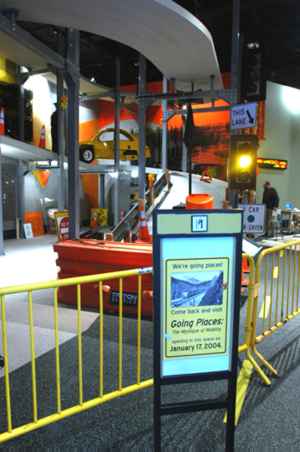 |
The entrance to the transportation exhibit beckons visitors at the
Minnesota History Center in St. Paul. Photo by Dave Gonzalez
|
The crucial role of transportation in the history and future of Minnesota receives
well-deserved attention from a new exhibit at the Minnesota History Center in
St. Paul.
The exhibit invites visitors to examine the earliest forms
of transportation and to become familiar with the state’s
most recent innovations in the field. Opening date for the
exhibit is Jan. 17. The history center is located at 345 Kellogg
Blvd., about four blocks south of the Capitol.
The exhibit’s debut closely follows the opening of the "America on the
Move" exhibition at the Smithsonian Institute in Washington, D.C. late
last year.
Titled "Going Places: The Mystique of Mobility," the display uses
photos, videos, maps and postcards to capture moments in the development of
the state’s complex transportation system and to convey the magnitude of future
transportation challenges.
The exhibit also addresses issues such as land use and traffic congestion to
help visitors make connections about the transportation choices they make and
their effects on the state’s environment and its future.
Interactive displays will enable visitors to imagine a leisurely ride on a
1910-era streetcar, explore the history of mass transit, crank the engine of
a 1915 Model T Ford and create their own personalized vehicles.
Representatives from Mn/DOT and other transportation-related organizations
worked with the history center staff to develop the exhibit. The exhibit, which
occupies 5,600 square feet of space at the center, will be displayed until 2009.
Museum officials estimate that 1.5 million people will visit the site during
the next five years.
Loris Gregory, an exhibit developer, credited several Mn/DOT employees who
helped develop parts of the exhibit such as photos, graphic elements and relocating
the Work Zone Charlie Brown statue to the history center.
The federal Transportation Equity Act provided funding for the exhibit for
the 21st Century through the U.S. Department of Transportation as did corporate
sponsorships and private donations.
"Multimedia programs, hands-on activities and voices and images of Minnesotans
past and present will make this exhibit a lively place for exploration, conversation,
reflection and learning," Gregory said.
For more information, see the History
Center Web site.
By Craig Wilkins
History center holds Work Zone Safety Charlie in isolation
Known best for collecting lipstick on his expansive, bald head, the
statue of Work Zone Safety Charlie is being examined closely by the
Minnesota History Center staff for other substances before he starts
promoting the new transportation display there.
It’s routine; all new exhibit pieces are held to ensure they are free
of insects, insect eggs, spiders or chemicals that could damage documents
and other artifacts.
When he gets the final OK, Charlie will direct visitors toward the
new exhibit.
Charlie’s history center assignment will last six months. At that point,
he will be free to pursue other interests.
|
|
back

|
 |
Productivity, cost management pilot process focuses on Mn/DOT priorities |
 |
 |
What does it really cost to provide our products and services? How can we cut
costs and still deliver value to our customers?
Those are questions Mn/DOT hopes to answer with a productivity and cost management
pilot process that the Engineering Services Division and the Office of Finance
will conduct in 2004.
Guided by the Pawlenty-Molnau budget principles of managing for results and
funding what is essential, the pilot will address Mn/DOT’s strategic goal of
working better and being more accountable for our actions.
"The productivity and cost management process will help Mn/DOT better
understand costs and what drives them," said Scott Peterson, director,
Office of Finance. "This will help us achieve our mission more cost-effectively."
The pilot will evaluate the cost relationships and cost effectiveness of program
delivery work processes, beginning with plan delivery. This will be done by
determining the relationship of program delivery costs to program size and composition;
comparing costs of tasks performed in-house to consultant costs, and examining
Mn/DOT overhead costs for billing purposes.
"This process will provide indicators, relationships and benchmarks to
help us measure the performance of Mn/DOT’s program delivery process and improve
our understanding of program delivery costs," said Dick Stehr, Engineering
Services Division director. "We will use these insights to guide improvement
efforts."
Over the next two months, a project team will be identified to develop a work
plan for the pilot process. Look for more information about the pilot on the
Office of Finance Web site at http://ihub.cbg/index/index.html.
For more information, contact Larry Moser, Office of Finance, 651/296-1602 or
Mary Prescott, Engineering Services Division, 651/297-2250.
By Donna Lindberg
|
back

|
 |
Employees’ generosity brightens holidays for others |
 |
 |
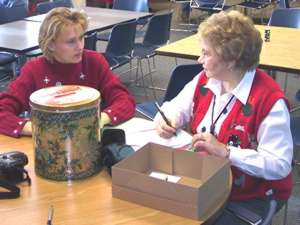 |
Detroit Lakes/District 4's Trudy Kordosky and Shirley Rislund accepted
donations for the district's fundraising effort that contributed more
than $1,000 to a hospice program in northwestern Minnesota. Photo
by Robert Kotaska
|
Mn/DOT employees opened their hearts and their wallets during the holiday season
to help the sick, the hungry and the homeless.
Employees’ care for their less fortunate friends and neighbors showed in contributions
of money, food and time to help others.
For the ninth consecutive year, employees at Detroit Lakes/District 4 raised
money for a hospice program that serves people in northwestern Minnesota. The
first fundraising effort for the hospice netted about $50. This year’s contributions
totaled more than $1,000, said Judy Jacobs, district public affairs coordinator.
Total District 4 employee contributions to the facility now exceed $5,000 since
1994.
At Rochester and Owatonna, District 6 employees contributed toys and food to
needy families. Brian Jergenson, district public affairs coordinator, organized
volunteers from the district office to ring bells at Salvation Army collection
spots in the Rochester area.
Office of Aeronautics employees donated toys for children and robes and slippers
for adults to a women’s shelter in West St. Paul. The office also donated cash
raised from a soup lunch event and foodstuffs to a food shelf in St. Paul.
Dan Riser, one of the organizers of Aeronautics’ charitable work, said the
office’s donations also inspired individual employees to make other gifts as
well.
"We were happy to make the donations and the people who received were
happy as well," he said.
In the Central Office, a silent auction held by Human Resources employees raised
$580 to support two needy families chosen by staff members and by the Children’s
Home Society. The families received clothing, household items and gift certificates.
Another silent auction conducted by the Office of Communications generated
nearly $300 in donations for the Red Cross to support members of the U. S. military
deployed overseas.
Employees in the Office of Construction gave more than $400 to Second Harvest,
a private agency that supports community food shelves statewide.
Capitol complex employees reflected the spirit of the season by donating 32
pints of blood on New Year’s Eve day. Jon Elftmann, Technical Support, said
the Red Cross always makes its goal when its Bloodmobile visits Mn/DOT’s Central
Office.
Elftmann, who has been coordinating Mn/DOT’s blood drive effort for more than
20 years, said the level of donations was good considering that many employees
took vacation leave during the holiday period.
The Hiway Federal Credit Union, whose members include many Mn/DOT employees,
joined the holiday giving as well. The credit union donated four vanloads of
gifts to the Toys for Tots program and gave nearly 100 pounds of food collected
from member donations to a St. Paul food shelf.
Colleen Leuschner, chair of the community service committee, said the credit
union also donated school supplies plus hats, mittens and other clothing items
for use by students at the nearby Franklin Elementary School in St. Paul’s Mt.
Airy neighborhood.
Credit union employees, she said, contributed $300 to help a single-parent
family of three to buy clothing and other items during the holidays.
By Craig Wilkins
|
back

|
 |
Thakur expands Indian music, culture broadcasts to TV |
 |
 |
Mn/DOT’s Mukhtar Thakur widens his media reach for programming about Indian
music and culture with the start of a weekly TV show on Twin Cities Public Television’s
Channel 17.
The new half-hour program, known as "Geet Mala," airs Sundays at
10 p.m. The first broadcast was aired on Jan. 4. The TV show complements his
current radio program on KFAI-FM (90.3) that’s broadcast on Mondays evenings
at 7:30 p.m.
The program’s debut marks the first volunteer-produced show aired on a public
TV channel in the U.S. Geet Mala is one of several Minnesota-related productions
that TPT will broadcast during prime viewing hours on its Minnesota Channel
programming.
The phrase "Geet Mala" translates into English from Hindustani as
"stringed gems of songs."
Thakur, director of Technical Support, started the radio show in 1990 to give
voice and support to the popular music from the Indian subcontinent. The radio
show also includes news reports from the subcontinent, interviews with Asian
leaders and conversations with immigrants from India, Pakistan, Bangladesh,
Sri Lanka and Nepal.
Thakur, a native of India, lived in East Africa and Great Britain and worked
in Saudi Arabia before moving to the U. S. and starting his career with Mn/DOT
in 1987.
The TV program retains those features and adds film clips from the Indian cinema
industry, the world’s most prolific film industry.
Geet Mala will include music videos, Indian poetry, music from the Sufis and
other religious traditions as well as popular Indian music.
"The program will help meet the need to connect Americans with Indian
and other Asian cultures and to link Asians living here to our roots,"
Thakur said.
For more information, visit the program’s Web site at www.Geetmalatv.com.
By Craig Wilkins
|
back

|
 |
Cancer claims lives of Morris’ Mike Larson, Bemidji’s Bill Frost |
 |
 |
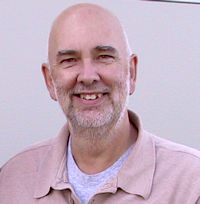 |
Mike Larson, 53, inventory and purchasing supervisor at Morris, died
Dec. 29.
|
Mike Larson, inventory and purchasing supervisor at Morris, and Bill Frost,
assistant to the state aid engineer at Bemidji, died from complications of cancer.
Larson, a 25-year employee with Mn/DOT, died Dec. 29. He was 53. Frost, whose
career with Mn/DOT spanned 39 years, died Jan. 1. He was 57.
Larson, was born in Portland, Ore., but spent much of early childhood in Minnesota
in Hitterdal and Hawley. He started working with Mn/DOT in 1978.
"Mike was one of a kind, a delightful breath of fresh air," said
co-worker Teresa Elkin, an employee development specialist at Detroit Lakes.
"He was always looking for ways to improve processes. Even if he knew an
idea he had would go nowhere, he’d mention it anyway. He’ll be greatly missed."
Joy Penney, district finance manager and Larson’s supervisor, said he constantly
challenged status quo thinking and left a legacy of improved inventory and purchasing
practices.
"He was a good person who cared about the people he worked with and helped
us keep a good sense of perspective about what we do," she said.
Larson is survived by his spouse, DeAnne Larson, and sons Chad and Aaron.
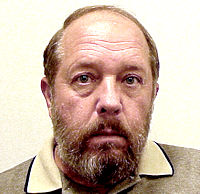 |
Bill Frost, 57, assistant to the state aid engineer at Bemidji, died
Jan. 1.
|
Frost, who was a senior engineering specialist, began working with Mn/DOT at
the former Golden Valley District office in 1964. He transferred to Bemidji
in 1976.
Dean Robertson, an engineering specialist in design and a co-worker of Frost’s
since his earliest years with the district, said Frost was well regarded for
his technical knowledge and was always helpful to other employees.
"He had a lot of technical experience in bridge construction and right
of way. He was a great resource for everyone and an easygoing person to work
with," Robertson said.
Frost was a native of Olivia, Minn. Spouse Linda Frost and son Jesse survive
him.
|
back

|
 |
DOER changes Employee Assistance Program availability |
 |
 |
The Department of Employee Relations modified the availability of its Employee
Assistance Program to make it more accessible to state employees throughout
Minnesota.
With the start of new provider contracts on Jan. 1, Behavioral Health Services,
Inc. will provide counseling services for individual employees and their dependents.
The services will be provided to employees who are members of the State Employee
Group Insurance Plan.
Employees may call 1-866/477-1586 in Greater Minnesota or 651/662-2586 to receive
an assessment from a counselor, who will provide immediate counseling or make
a referral to a local EAP providers, a community resource or services available
from the individual’s health plan. Phone service will be available 24 hours
a day.
BHSI will use many of the same providers in Greater Minnesota currently used
by DOER’s program. In the Twin Cities, BHSI will use clinics in Minneapolis,
St. Paul, Eagan, Golden Valley, North St. Paul, Shakopee and Woodbury for counseling
services.
Supervisors and managers will continue to receive behavioral health-related
employee, organizational or workplace consultation by internal DOER staff.
More information is available from the EAP
Web site.
|
back

|
 |
|
 |



